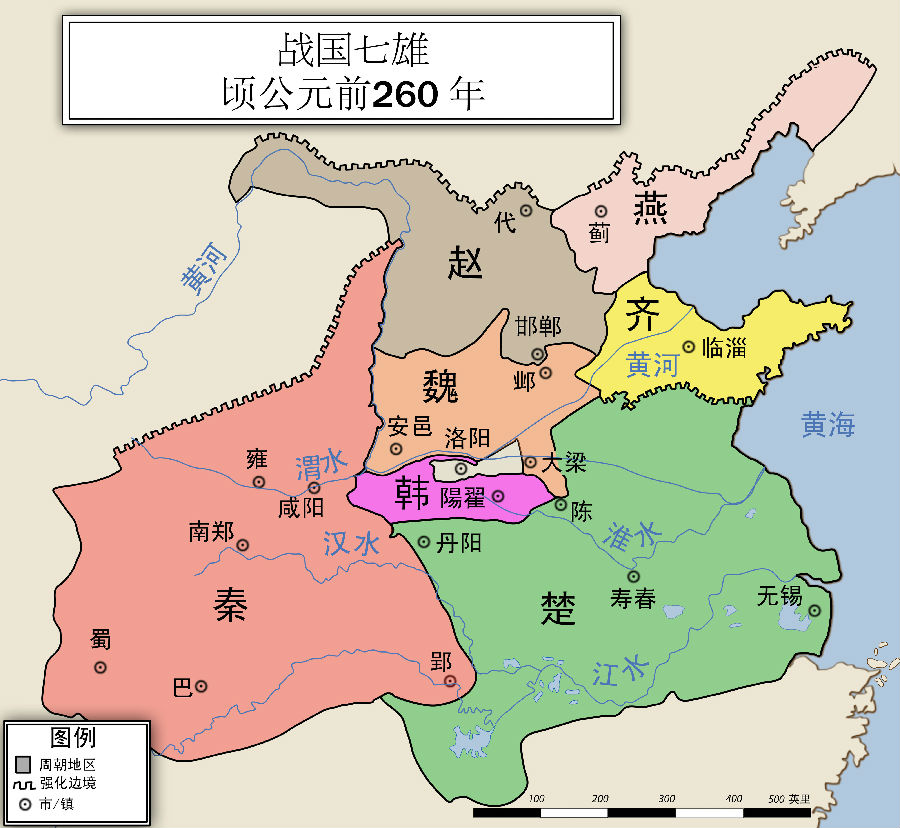(单词翻译:单击)
The Spring and Autumn Period and the Warring States Period
春秋战国时期
Warring States Period
战国时期
After long-term wars, seven kingdoms, namely Qi, Chu, Yan, Han, Zhao, Wei and Qin, appeared as the most powerful states in this period, known as the “Seven Overlords” in history.
经过长期的战争,齐,楚,燕,韩,赵,魏、秦,战国时期内最强大的国家,史称“战国七雄”。
To expand their forces and territories, the seven overlords, on the one hand, carried out reforms in their own states to strengthen themselves and,
为了扩大自己的势力范围和领土,这七大国一方面对内实行改革,使自己更大强大,
on the other, were warring against each other and scheming to annex other states, which gave rise to the situation of seven powerful states existing side by side and struggling against each other.
另一方面对外交战,意图兼并他国,这导致了战国七雄相互歌剧混战的局面。
Qin, situated in the remote west, used to be a vassal state enfeoffed by King Ping for Qin Xianggong’s contribution of escorting the king on his move east.
秦,位于西部偏远,曾经是周平王因秦襄公护送东迁有功而册封给他的诸侯国。
During the Spring and Autumn Period, Qin Mugong annexed twelve states, largely expanding his territory, making himself an overlord.
在春秋战国时期,秦穆公吞并十二个国家,极大地扩大了自己的领土,使其成为一代霸主。
During the Warring States Period, Qin, because of its outlying position, was more backward than the states in the Central Plains.
在战国时期,由于秦国偏远的地形,其相较于中原诸国落后的多。
When Qin Xiaogong was in power, Shangyang, an aristocratic descendant of the Wei kingdom, was entrusted by the monarch to carry out a series of reforms in 359 BC and 350 BC to strengthen the power of Qin.
秦孝公当政时,商鞅,卫国的贵族后裔,在公元前359年至公元前350年奉命开展了一系列的改革,以加强秦国的实力。
Shangyang’s reforms include abolishing the outdated well-field system, legalizing the private ownership of land, canceling the hereditary system of rank and initiating a county system.
商鞅变法包括废除过时的井田制,使土地私有制合法化,取消职级的世袭制,改用县制。
In addition, Qin also paid attention to the development of agriculture.
此外,秦还重视农业的发展。
Around 250 BC, Libing, a governor of Shu prefecture (present Sichuan Province), together with his son, directed the construction of Dujiangyan Irrigation Project, which not only controlled flooding but also irrigated the whole Chengdu Plain.
大约在公元前250年,李冰,蜀地的省长(现四川省),与其儿子一道,领导了都江堰水利工程的建造,它不仅控制了洪水的泛滥,同时还灌溉了整个成都平原。
Qin, based on the reforms and improvements, quickly became a powerful state, laying a solid foundation for the future unification of China by Emperor Qin Shi Huang.
秦在改革进步的基础上迅速成为一个实力强大的国家,为日后秦始皇统一中国奠定了坚实的基础。
At the end of Warring States, the royal house of Eastern Zhou existed in name only. In 256 BC, Qin dispatched army and defeated the Eastern Zhou Dynasty.
在战国末期,东周王室名存实亡。公元前256年,秦出动军队,打败东周。
Before long, after King Yingzheng succeeded to the throne, he expedited his project of annexation and finally in 221 BC united China and established a unified, multinational, autocratic and power-centralized state, putting an end to the Waning States Period.
没过多久,嬴政继承王位后,他加快吞的步伐并最终在公元前221年统一中国,建立起一个统一的多民族的专制集权的国家,结束了战国时期。
At the end of Western Han Dynasty (206 BC—24 AD), Liu Xiang, based on the information about this period, compiled a book and named it the History of Warring States according to the character of this period. Later generations then named this chaotic era the Warring States Period.
在西汉末期(公元前206年至公元24年),刘向在有关这一时期的资料的基础上,根据这一时期的特点,将史料编撰成书《战国策叙录》。后人遂将这个混乱的时代命名为战国时期。


